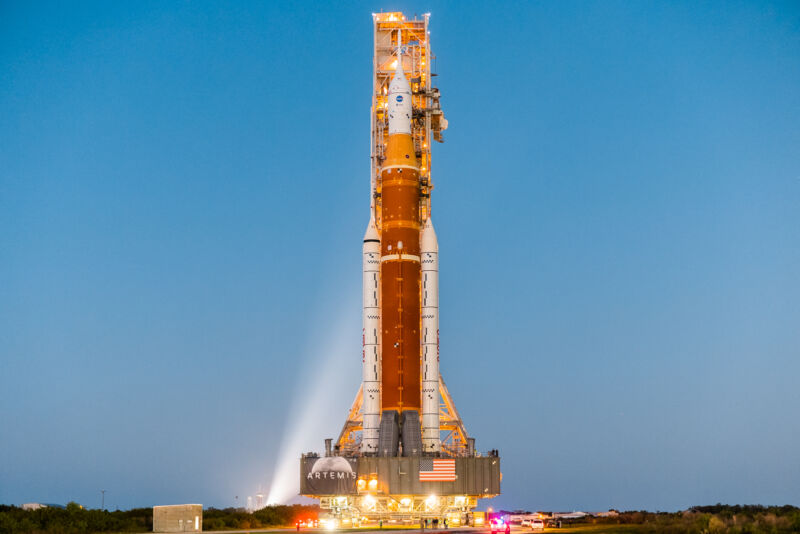A faulty sensor may have scrubbed the launch of NASA’s massive SLS rocket
[ad_1]

Trevor Mahlmann
After scrubbing a launch attempt of the Space Launch System rocket on Monday, NASA officials said they’re working toward a second attempt to fly the Artemis I mission on Saturday, September 3.
NASA flight controllers halted the first launch attempt after they were unable to verify that one of the SLS rocket’s four main engines—engine no. 3—had been properly cooled to a temperature of -420° Fahrenheit prior to ignition. The engines must be chilled to very cold temperatures to handle the injection of very cold liquid hydrogen and oxygen propellants.
During a news conference on Tuesday evening, NASA’s program manager for the SLS rocket, John Honeycutt, said his engineering team believed the engine had actually cooled down from ambient temperature to near the required level but that it was not properly measured by a faulty temperature sensor.
“The way the sensor is behaving does not line up with the physics of the situation,” Honeycutt said.
The problem for NASA is that the sensor cannot be easily replaced and would likely necessitate a rollback to the Vehicle Assembly Building at Kennedy Space Center in Florida, a few kilometers from the launch pad. This would delay the launch of the rocket at least into October, and the space agency is starting to get concerned about wear and tear on a rocket that has now been stacked for nearly a full year.
Honeycutt said he is confident that liquid hydrogen was flowing into engine no. 3 during the countdown on Monday and that other sensors, including pressure measurements, indicated that the engine was in an environment that would have properly cooled it down. Therefore, he said, his team is working on a “flight rationale” plan that would allow the rocket to launch without getting good data from the temperature sensor on the engine.
“We will be looking at all of the other data we have and [will] use it to make an informed decision,” he said.
Accordingly, NASA’s current plan involves some work at the launch pad today, including the inspection of an area where there was a small hydrogen leak during Monday’s countdown. Then, if officials are satisfied with those inspections and their flight rationale for dealing with the faulty temperature sensor, the agency will start counting down on Thursday. On this timeline, fueling operations would begin on Saturday morning, ahead of the 2:17 pm ET (18:17 UTC) opening of a two-hour launch window. To give the launch team more time to work on the engine chill-down issue, the process known as “conditioning” the engines would begin earlier in the countdown than on Monday.
It was not immediately clear from Tuesday’s news conference what the implications of launching with a warmer-than-normal main engine would be. From a physics standpoint, igniting super-chilled propellants in a warmer-than-anticipated engine would likely severely damage the RS-25 engine’s turbopump, at a minimum. Presumably, therefore, NASA would not launch the SLS rocket without high confidence in its flight rationale.
NASA has until September 5 to launch the booster before it must be taken off the pad for refurbishment. As the September 3 launch date approaches, the space agency will be closely watching the weather forecast and managing technical issues. Although thunderstorms frequently develop along the Florida coast during summer afternoons, Launch Weather Officer Mike Burger said the onshore flow should be fairly strong this weekend. That should push the sea breeze further inland and potentially allow for some opportunities to launch during the two-hour window. If weather scrubs the attempt, NASA is making provisions to attempt a launch on September 5.
Officials insisted during Tuesday’s news conference that they were confident in proceeding toward a launch attempt. Although the space agency heavily promoted the first Artemis I launch attempt on Monday—the launch of an uncrewed Orion spacecraft to the Moon was feted with celebrity appearances, social media promotion, and a visit by Vice President Kamala Harris to the Florida spaceport—NASA has yet to complete a fueling test of the vehicle.
Despite this, the space agency hopes that it will be able to fully fuel the rocket on Saturday and count all the way down to T-0 without any further issues.
[ad_2]
Read More:A faulty sensor may have scrubbed the launch of NASA’s massive SLS rocket

Comments are closed.